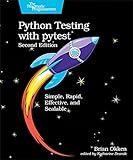Best Python Testing Tools to Buy in January 2026
In pytest, you can handle sys.argv by using the built-in pytestconfig fixture. This fixture provides access to the command line arguments passed to pytest. You can access these arguments using the pytestconfig.getoption() method. For example, you can retrieve the value of a specific command line argument with pytestconfig.getoption('myargument'). You can then use this value in your test functions to customize the behavior of your tests based on the command line arguments passed to pytest.
How to create a helper function for sys.argv handling in pytest?
You can create a helper function for handling sys.argv in pytest by using the pytest_addoption hook function provided by pytest. Here’s an example of how you can create a helper function for handling command line arguments in pytest:
# conftest.py
import pytest
def pytest_addoption(parser): parser.addoption("--myoption", action="store", default=None, help="My custom command line option")
def get_command_line_option(request, option_name): return request.config.getoption(option_name)
You can then use this helper function in your test modules to get the value of the command line option specified:
# test_sample.py
def test_command_line_option(request): my_option = get_command_line_option(request, "--myoption") assert my_option is not None
When running your tests, you can pass the command line option --myoption=value to set the value for the custom option:
pytest test_sample.py --myoption=value
What is the impact of using sys.argv in parallel test execution with pytest?
Using sys.argv in parallel test execution with pytest can have several impacts on the test execution process:
- Parallelization: By utilizing sys.argv in parallel test execution, you can pass arguments to pytest that enable parallel test execution. This can help speed up the test execution process by running multiple tests concurrently on different processes or threads.
- Isolation: sys.argv can be used to pass arguments that isolate specific tests or test suites for parallel execution. This can help prevent interference between tests and ensure that each test runs in its own isolated environment.
- Customization: Using sys.argv allows you to customize the test execution process by passing specific arguments or options to pytest. This can help tailor the test execution to meet your specific requirements or configurations.
Overall, utilizing sys.argv in parallel test execution with pytest can provide flexibility, speed, and customization to the test execution process. However, it is essential to ensure proper handling of arguments to avoid conflicts or unexpected behavior in the test execution.
How to troubleshoot sys.argv related errors in pytest test runs?
- Check if the correct number of arguments are being passed to the script. Make sure that the number of arguments in the sys.argv list matches the number of arguments expected by the script.
- Verify that the arguments are being passed in the correct order. If the script expects arguments in a specific order, make sure that they are passed in that order when running the test.
- Check for any syntax errors in the script that may be causing issues with parsing the command line arguments. Make sure that the script is properly handling the arguments being passed to it.
- If the script is being executed in a virtual environment, ensure that the correct virtual environment is activated before running the test.
- Use print statements or logging to debug and verify the values of the sys.argv list in the testing environment to ensure that the arguments are being passed correctly.
- If the above steps do not resolve the issue, consider using a debugger to step through the script and see where the error is occurring in more detail.
- If all else fails, reach out to the pytest community for help or consult the documentation for pytest and sys.argv for additional troubleshooting tips.
What is the behavior of sys.argv in pytest fixtures with autouse=True?
When using a pytest fixture with autouse=True, the sys.argv behavior will not be affected. The sys.argv variable contains a list of command-line arguments passed to the Python script when it was executed. When using a pytest fixture with autouse=True, the fixture will be automatically executed for every test function without requiring it to be explicitly passed as an argument. This behavior does not interfere with the sys.argv variable, and it will still contain the command-line arguments passed to the script.
How to handle invalid inputs in sys.argv using pytest?
You can handle invalid inputs in sys.argv using pytest by creating test cases that specifically target the invalid inputs. Here is an example of how you can do this:
- Create a function that takes sys.argv as input and processes it in some way. For example, you could have a function that checks if the input is a valid integer:
import sys
def process_input(argv): try: num = int(argv[1]) return num except (IndexError, ValueError): return None
- Write test cases using pytest to test the behavior of the process_input function with invalid inputs:
import pytest
def test_process_input_invalid_input(): assert process_input(['script_name']) is None
def test_process_input_noninteger_input(): assert process_input(['script_name', 'abc']) is None
- Run the pytest command in your terminal to run the test cases:
pytest test_file.py
This will run the test cases and show you the results. If any of the test cases fail, you will know that your function is not handling invalid inputs correctly.
What is the difference between sys.argv and argparse in pytest?
sys.argv is a list in Python that contains the command-line arguments passed to the script when it is executed. It is a simple way to access the command-line arguments directly without any additional parsing or manipulation.
argparse, on the other hand, is a more sophisticated module in Python that provides a way to define and parse command-line arguments in a more structured and flexible manner. It allows for specifying various options, flags, arguments, and help messages for a command-line interface.
In the context of pytest, using sys.argv directly can be cumbersome and error-prone when dealing with complex test configurations and options. argparse, on the other hand, provides a more robust and user-friendly way to define and parse command-line arguments for configuring and running pytest tests. It allows for specifying options such as test selection, verbosity, output formats, and more, making it easier to customize and control the test execution process.




